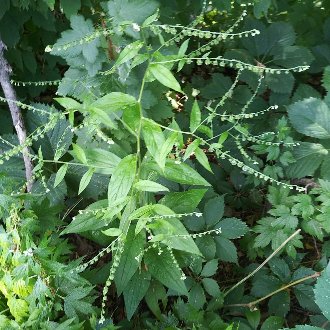Virginia Stickseed (Hackelia virginiana (L.) I.M. Johnst.)
Also known as beggarslice, beggar's lice, sticktight.
↑Range - Expand
| Legend | Color |
| Native | |
| Native or Not Present |
This tentative map is based on our own research. It may have limited data on Canada and/or Mexico, and there is some subjectivity in our assignment of plants as introduced vs. expanded. Read more in this blog post.
Although this plant occurs somewhere in each of these regions, it may only occur in a small part of some or all of them.
↑Habitat
Found in a wide range of forested to partly-shaded habitats, on disturbed sites with close to neutral pH. This species has low fidelity to any particular habitat other than needing some shade, disturbance, and higher soil pH. Natural habitats include forests and woodland borders, especially forests that have recently burned, and floodplain forests. Often more common in anthropogenic habitats, including where roads and paths cut through forests, along power line clearances, shaded fencerows, and shaded spots in pastures.
It tolerates a wide range of moisture conditions from moist to dry, preferring mesic conditions. It also tolerates a wide range of soil conditions, but prefers more fertile soils, and is absent from acidic soils.
This species is resistant to deer browsing and the presence of its mature seedpods also tends to deter deer, so it tends to thrive in areas with deer overbrowsing. It also is more common in shady parts of overgrazed pastures as cows also avoid it.
Although people tend to view this plant as an undesireable weed and often go out of their way to kill it, humans have tended to increase the habitat for this plant by creating more edge habitats and disturbance in woodlands, as well as indirectly by encouraging overpopulation of deer. However, even where it is more common, it usually is found as scattered individuals or small groups of individuals, and does not usually form large monocultures.
↑Life Cycle
This species is a biennial. Plants grow as a basal rosette during their first year, and grow upright during their second year.
↑Faunal Associations
The foliage is avoided by most mammalian herbivores. The seeds are distributed by sticking to animal fur or clothing; the seeds tend to be stickier and harder to remove than most other plants that use a similar mechanism.
The relationship between this plant and insect specialists is not well-known. The flea beetle Longitarsus melanurus feeds on the leaves of this species along with other members of the Boraginaceae or borage family. Although there are a number of Lepidoptera species that have been documented eating other Hackelia species in North America, we have not found any documentation of any feeding specifically on this species.
↑Links & External Resources
• Hackelia virginiana (Stickseed) | Illinois Wildflowers (About This Site)
• Hackelia virginiana (Beggarslice) | USDA PLANTS Database (About This Site)
• Hackelia virginiana | Go Botany (About This Site)
• Hackelia virginiana | Biota of North America Project (BONAP) (About This Site)
• Hackelia virginiana | NatureServe Explorer (About This Site)
• Hackelia virginiana | Missouri Plants (About This Site)
• Beggarslice | Maryland Biodiversity Project (About This Site)
• Hackelia virginiana (Virginia Stickseed) | Minnesota Wildflowers (About This Site)
• Hackelia virginiana (L.) I.M.Johnston (Virginia Stickseed) | Digital Atlas of the Virginia Flora (About This Site)




